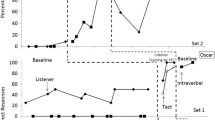Abstract
We assessed the efficiency of tact and listener training for eight participants with autism spectrum disorder. Tact and listener probes were conducted in baseline for all target sets, and then tact training was initiated with one and listener training with another. Following mastery of one set, tact and listener probes were conducted with only the sets assigned to the same modality of training (i.e., sets 1, 3, and 5 for tact; sets 2, 4, and 6 for listener). Training and probes were repeated for all sets. The measures of efficiency included the number of skills mastered through direct training, the number of skills that emerged without training, the number of trials-to-criterion, and maintenance of skills. Clinical programming based on each participant’s results is discussed. For six participants, tact training was more efficient than listener training across multiple measures. For the remaining two participants, tact training and listener training were considered equivalent.




Similar content being viewed by others
References
Baer, D. M., Wolf, M. M., & Risley, T. R. (1968). Some current dimensions of applied behavior analysis. Journal of Applied Behavior Analysis, 1, 91–97. doi:10.1901/jaba.1968.1-91.
Corrigan, P. W. (2001). Strategies for disseminating evidence-based practices to staff who treat people with serious mental illness. Psychiatric Services, 52(12), 1598–1606. doi:10.1176/appi.ps.52.12.1598.
Delfs, C. H., & Frampton, S. E. (2014). Practical implications of evaluating the efficiency of listener and tact instruction for children with autism. Journal of Applied Behavior Analysis, 47, 810–813. doi:10.1002/jaba.176.
Delfs, C. H., Conine, D. E., Frampton, S. E., Shillingsburg, M. A., & Robinson, H. C. (2014). Evaluation of the efficiency of listener and tact instruction for children with autism. Journal of Applied Behavior Analysis, 47, 793–809. doi:10.1002/jaba.166.
Fiorile, C. A., & Greer, D. A. (2007). The induction of naming in children with no prior tact responses as a function of multiple exemplar histories of instruction. The Analysis of Verbal Behavior, 23, 71–87.
Gast, D. L. (2010). Single subject research methodology in behavioral sciences. New York: Routledge.
Gilic, L., & Greer, R. D. (2011). Establishing naming in typically developing children as a function of multiple exemplar speaker and listener experiences. The Analysis of Verbal Behavior, 27, 157–178.
Greer, R. D., Stolfi, L., Chavez-Brown, M., & Rivera-Valdez, C. (2005). The emergence of the listener to speaker component of naming in children as a function of multiple exemplar instruction. The Analysis of Verbal Behavior, 21, 123–134.
Greer, R. D., Stolfi, L., & Pistoljevic, N. (2007). Emergence of naming in preschoolers: a comparison of multiple and single exemplar instruction. European Journal of Behavior Analysis, 8(2), 119–131.
Horne, P. J., & Lowe, C. F. (1996). On the origins of naming and other symbolic behavior. Journal of the Experimental Analysis of Behavior, 65, 185–241. doi:10.1901/jeab.1996.65-185.
Horne, P. J., Lowe, C. F., & Randle, V. R. (2004). Naming and categorization in young children: II. Listener behavior training. Journal of the Experimental Analysis of Behavior, 81, 267–288. doi:10.1901/jeab.2004.81-267.
Kobari-Wright, V. V., & Miguel, C. F. (2014). The effects of listener training on the emergence of categorization and speaker behavior in children with autism. Journal of Applied Behavior Analysis, 47, 431–436. doi:10.1002/jaba.115.
Lee, G. P., Miguel, C. F., Darcey, E. K., & Jennings, A. M. (2015). A further evaluation of the effects of listener training on derived categorization and speaker behavior in children with autism. Research in Autism Spectrum Disorders, 19, 72–81. doi:10.1016/j.rasd.2015.04.007.
Longano, J. M., & Greer, R. D. (2014). Is the source of reinforcement for naming multiple conditioned reinforcers for observing responses? The Analysis of Verbal Behavior, 31, 96–117. doi:10.1007/s40616-014-0022-y.
Lowe, C. F., Horne, P. J., Harris, F. D., & Randle, V. R. (2002). Naming and categorization in young children: vocal tact training. Journal of the Experimental Analysis of Behavior, 78, 527–549. doi:10.1901/jeab.2002.78-527.
Lowe, C. F., Horne, P. J., & Hughes, J. C. (2005). Naming and categorization in young children: III: vocal tact training and transfer of function. Journal of Experimental Analysis of Behavior, 83, 47–65. doi:10.1901/jeab.2005.31-04.
Miguel, C. F., & Kobari-Wright, V. V. (2013). The effects of tact training on the emergence of categorization and listener behavior in children with autism. Journal of Applied Behavior Analysis, 46, 669–673. doi:10.1002/jaba.62.
Miguel, C. F., & Petursdottir, A. I. (2009). Naming and frames of coordination. In R. A. Rehfeldt & Y. Barnes-Holmes (Eds.), Derived relational responding: applications for learnings with autism and other developmental disabilities (pp. 129–148). Oakland, CA: New Harbinger Publications.
Miguel, C. F., Petursdottir, A. I., Carr, J. E., & Michael, J. (2008). The role of naming in stimulus categorization by preschool children. Journal of Experimental Analysis of Behavior, 89, 383–405. doi:10.1901/jeab.2008-89-383.
Petursdottir, A. I., & Carr, J. E. (2011). A review of recommendations for sequencing receptive and expressive language instruction. Journal of Applied Behavior Analysis, 44, 859–876. doi:10.1901/jaba.2011.44-859.
Skinner, B. F. (1957). Verbal Behavior. New York: Appleton-Century-Crofts.
Sprinkle, E. C., & Miguel, C. F. (2012). The effects of listener and speaker training on emergent relations in children with autism. The Analysis of Verbal Behavior, 28, 111–117.
Sundberg, M. L. (2008). VB-MAPP Verbal Behavior Milestones Assessment and Placement Program: a language and social skills assessment program for children with autism or other developmental disabilities: guide. Concord, CA: AVB Press.
Sundberg, M. L., & Michael, J. (2001). The benefits of Skinner’s analysis of verbal behavior for children with autism. Behavior Modification, 25, 698–724.
Szatmari, P., Bryson, S., Boyle, M., Streiner, D., & Duku, E. (2003). Predictors of outcome among high functioning children with autism and asperger syndrome. Journal of Child Psychology and Psychiatry, 44(4), 520–528. doi:10.1111/1469-7610.00141.
Venter, A., Lord, C., & Schopler, E. (1992). A follow-up study of high-functioning autistic children. Journal of Child Psychology and Psychiatry, 33, 489–597. doi:10.1111/j.1469-7610.1992.tb0087.x.
Wolery, M., Ault, M. J., & Doyle, P. M. (1992). Teaching students with moderate to severe disabilities: use of response prompting strategies. New York, NY: Longman.
Wynn, J. W., & Smith, T. (2003). Generalization between receptive and expressive language in young children with autism. Behavioral Interventions, 18, 245–266. doi:10.1002/bin.142.
Acknowledgements
Sarah E. Frampton, Language and Learning Clinic, Marcus Autism Center; Hannah C. Robinson, Language and Learning Clinic, Marcus Autism Center; Daniel E. Conine, Language and Learning Clinic, Marcus Autism Center; Caitlin H. Delfs, Language and Learning Clinic, Marcus Autism Center, and Department of Pediatrics, Emory University School of Medicine
Author information
Authors and Affiliations
Corresponding author
Ethics declarations
All procedures performed in studies involving human participants were in accordance with the ethical standards of the institutional and/or national research committee and with the 1964 Helsinki declaration and its later amendments or comparable ethical standards. Informed consent was obtained for all individuals in the study.
Conflict of Interest
The authors declare that they have no conflict of interest.
Additional information
Danny Conine is now at the University of Florida.
Implications for Practice
• Tact and listener comparisons can be conducted in the context of daily clinical services, by assigned clinical staff, with individualized procedures for each participant.
• Probe and training procedures can be adapted to require less intrusive data collection while still allowing clinicians to make data-based decisions regarding the outcomes.
• Tact training was shown to be more efficient or as efficient for all participants; however, differences across measures were detected for most participants.
• The proposed decision-making model may assist clinicians in using their data to guide clinical programming.
Appendix
Appendix
Rights and permissions
About this article
Cite this article
Frampton, S.E., Robinson, H.C., Conine, D.E. et al. An Abbreviated Evaluation of the Efficiency of Listener and Tact Instruction for Children with Autism. Behav Analysis Practice 10, 131–144 (2017). https://doi.org/10.1007/s40617-017-0175-y
Published:
Issue Date:
DOI: https://doi.org/10.1007/s40617-017-0175-y




